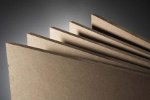Sticking with MDI
23 December 2009Many people will associate MDI (Methylene Diphenyl di-isocyanate) resins with the manufacture of OSB, but in fact this versatile binder can be applied to the production of other composite wood products, including MDF and particleboard, says MDI manufacturer Huntsman.
Used in the manufacture of panels such as OSB, MDF, particleboard and lightweight wood fibre insulation products, MDI technology has been around for over 30 years but has sometimes been considered a high-cost alternative to conventional formaldehyde based resins. However, Iain Stanton, Composite Wood Panel (CWP) marketing manager for Europe and Asia at Huntsman, will tell you this simply isn’t the case.
“MDI is a tried and tested technology and we have been able to prove time and time again that it can increase panel performance and is an affordable option for manufacturers of composite wood products,he says. “For me, the reason why it has taken so long for the industry to really wake up to the opportunities MDI presents is a lack of understanding, which is why Huntsman is dedicated to communicating the real life applications and tangible benefits it offers our customers so that manufacturers can move forward.”
In order to understand why MDI is such a versatile and efficient binder, it is helpful to start with the science behind the technology, suggests Mr Stanton.
MDI provides a very strong bond with the wood particles or strands as it has a reaction with the wood itself, when put under intense heat, creating a chemical weld. This is a different and superior type of bond to the mechanical weld that formaldehyde based products produce, says Mr Stanton; in the case of formaldehyde products, it is clear to see where one material starts and another ends, he says.
However, MDI bonds by forming a diffusion interphase, the resin spreads over the surface of the wood and penetrates into cracks, cell lumen and even cell walls, he explains. Penetration depths of up to 1mm are readily achieved, which is well beyond the three-cell depths commonly assumed to be needed for wood resins to provide adequate adhesive strength.
In the diffusion interphase the MDI effectively becomes one with the wood and this, long with the penetration and the spread, is responsible for the high quality performance expected from MDI bonded wood, including the resistance to thickness swell and the high strengths, says the marketing manager.
“MDI can help manufacturers of composite wood products such as medium density fibreboard (MDF) and particleboard to achieve a more stable processing window; improved material performance in terms of internal bond strength; and increased protection against thickness swell, while reducing production costs.says Mr Stanton.
“But to really bring this to life for potential new customers, Huntsman has a technical support team on hand that can offer a realistic trial within manufacturers’ own production plants. Our wood products development centre tests MDI resins with the specific source of wood that each client uses in order to create an individual formula, while our portable equipment allows us to take this direct to them to trial and see how it works before they make the investment.
“In fact, we believe we are the only MDI producer to have this support framework in place. We believe that a ‘try before you buy’ approach is a crucial part of the process for customers considering the switch to MDI. As a testament to the success of the trial process, during the 17 years I have been in the composite wood panel industry, I cannot remember a single time when a client has tried MDI for OSB or MDF panel manufacture and then reverted back to the method they used before. For me, that has to speak volumes about both our confidence in this technology and about the results our customers see when they make this change.”
Huntsman says the benefits that MDI, with its strong chemical weld, can offer manufacturers within the production of wood panels include the following:
• Increased mill productivity and creation of better operating parameters and savings in drying, blending and pressing
• Increased tolerance to a variety of wood species
• Increase in the panels’ physical property performance
• Increased ability to manufacture speciality products
• Reduced blender cleaning
• Fast curing
• Ease of adding biocides or fire retardants
• Finished panels that are smooth, light and more natural in appearance
• Improved moisture resistance
• Excellent strength-to-weight ratio
• Compared with traditional formaldehyde options, MDI resins require a lower dosage, making them a cost-effective binding option when comparing on a cost-per-cubic-metre basis.
The case for MDI has been coming into its own over the past year, due to new stringent legislation which requires wood panel producers to limit the levels of formaldehyde emitted from their products. As a result, the industry is entering into a debate as to how to meet these new standards, with MDI entering the spotlight as the no-added-formaldehyde solution, says Huntsman.
Mr Stanton explains: “For example, in America, the use of MDI in the manufacture of MDF will make it ‘exempt’ within the requirements of Section 93120.3 of the California Air Resources Board (CARB) standards. The level I legislation was implemented from 1st January 2009, placing strict limits on the level of permissible formaldehyde emitted from wood based panels and will become even more restrictive in 2011, when CARB level II comes into effect for particleboard and MDF production.
“A number of initiatives outside the US have been generated as a result of the first phase, such as the development of the EPF-S standard in Europe, as major furniture producers are realising the need to be more aware and selective about the products they produce and sell,he says.
“Also, in Asia, where the manufacture of MDF and particleboard is more widespread, using MDI products like Huntsman’s I-BOND resins, means that manufacturers’ products can be classified as both CARB I and CARB II compliant, as well as becoming Japanese F**** compliant,continues Mr Stanton.
“It is clear to see the momentum that these regulations are gathering worldwide and we are seeing more producers coming to us to try MDI technology for themselves now while they can fully evaluate the advantages of making the change sooner rather than later.”
Huntsman also says it has a unique range of internal and external release solutions called I-Release that can be used when manufacturing OSB, MDF, particleboard and wood fibre insulation board.
It says that, developed to complement the company’s I-BOND range of MDI resins, there is a release system to suit every type of panel, and for both internal and external application, to ensure a smooth and efficient production process. For example, for the manufacture of MDF, Huntsman has developed two groups of release agents. The first can be applied internally to the wood fibres, mixed in-line with the resin and added directly to the blowline. In this situation, it is used in higher quantities but there are no emissions as a result.
The second option is an external release agent that can be sprayed directly onto the press belt of continuous presses. Because it is applied directly to the press belt, a lower dosage is required, which is claimed to make this system very cost-effective.
Huntsman says it is able to evaluate its customer’s external release agent needs so that individual requirements can be identified and the right solutions provided, using its unique PWM (Pulse Width Modulated) trial equipment. The dedicated technical team is on hand throughout the process. In this way, Huntsman says it is able to show manufacturers that MDI resins and their release agents are cost-effective and will deliver tangible benefits within the production of composite wood panels.



